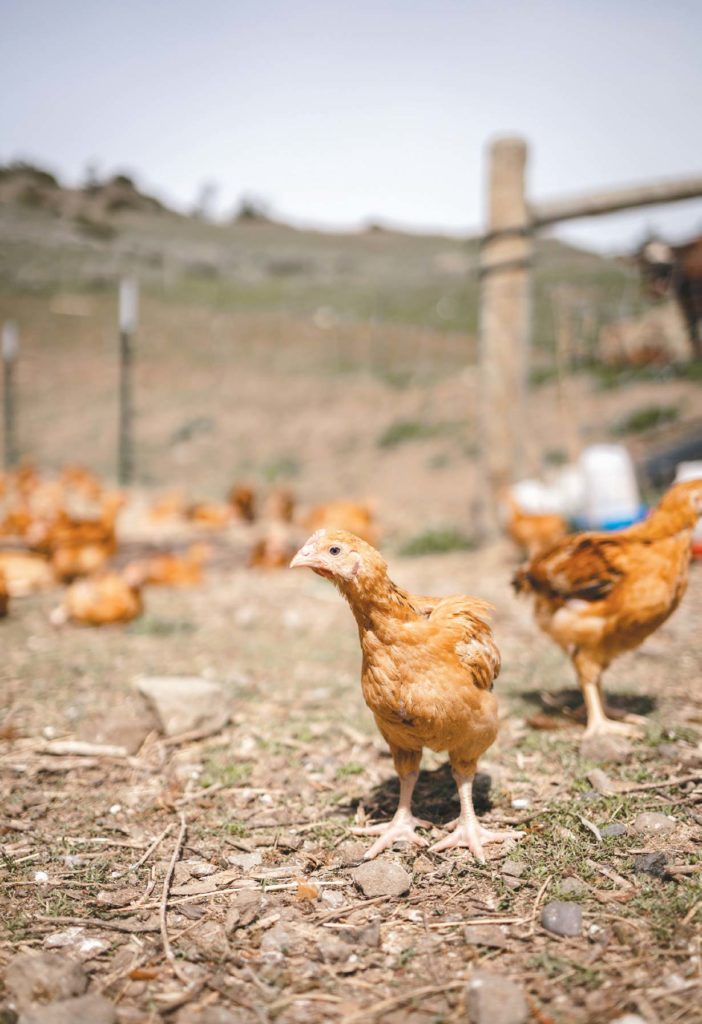Photo courtesy of Black Dog Farm
Montana’s Supply Isn’t Meeting Demand
As Bozeman and other hot-market areas around the state continue to boom, the demand for local Montana poultry is also skyrocketing. Raising chickens has a relatively low barrier to entry, but most people are unaware of the difficulties associated with processing birds for market.
REGULATIONS
Wyatt Nelson managed the meat and seafood department at the Bozeman Community Food Co-op for eight years before taking on the position as the president of Wild West Local Foods. Over the last few years, he has seen such a noticeable increase in demand for local poultry that it has been hard to keep products on the shelves.
“With the influx of people moving here from places like Seattle and California where the availability of local poultry is much higher, the demand has gone way up,” Nelson says. “People are recognizing that if they can talk to the source [of their meat], they can feel better about consuming the product, but local, pasture-raised chicken is expensive. It’s not affordable for everyone.”
Part of why local poultry remains in short supply is due to the state’s harsh environment. Between the colder climate and countless predators, it’s a difficult job to ensure the birds survive. There’s also the processing dilemma: Montana has strict and complicated regulations around poultry processing that protect consumer health but also make it economically and logistically difficult for producers.
Montana’s poultry inspection program is administered by the Montana Department of Livestock Meat and Poultry Inspection Bureau. Processors are also regulated by the Food and Consumer Safety Section of the Montana Department of Public Health and Human Services. Large-scale producers must follow stringent regulations, however, there are several exemptions that allow smaller-scale operations room for much-needed flexibility.
One such example is the 20,000-bird exemption. This exemption still requires licensing with the Montana Department of Livestock and products must meet specific labeling requirements, but it allows producers to process up to 20,000 birds raised on their own property without an inspector present. Those birds can then be sold and distributed within Montana. There is also a 1,000-bird exemption, which allows for the slaughter and processing of up to 1,000 of a producer’s own birds without an inspection, licensing, or labeling.
KEEPING UP
In his previous position as the Co-op’s meat and seafood department manager, Nelson filled as much customer demand for local poultry as he could with chickens raised and processed by Living River Farms in Stevensville, Montana.
Living River Farms is owned and run by Beau McLean and Christopher Green, who plan to produce 16,000 pasture- raised broiler chickens this year. For the second year in a row, they will be processing their chickens at a facility they built on the farm.
Before building their own facility, McLean and Green processed their birds at a State-licensed poultry processing hub in the Bitterroot Valley that they established in 2015 with the help of Homestead Organics. The Montana Poultry Growers Co-op ran the facility in Hamilton, Montana, and McLean and Green were able to meet their butchering needs while providing a much-needed processing option for other community members and farms.
“We butchered about 10,000 of our own birds and another 4,000 from other farms annually at the co-op,” says McLean. “It wasn’t something we were getting paid to do, though the overhead costs were covered by a membership fee paid by farms and individuals who utilized the facility. Because of State inspection mandates, we had to butcher at least 300 birds a day to make it all cost effective.”
In Montana, the requirements for butchering chickens for other individuals and farms include having an inspector on the premises during every step of processing. “There’s a time limit you get for processing,” McLean says. “If the inspector has to stay longer than the day you’re allotted, you’re charged by the hour. We had to pay more employees to get the job done faster, at a higher cost.”
At the time, the facility was the only place in the state that could legally process chickens from other farms, yet the facility did not have the capacity to meet the entire state’s demand for poultry processing. The situation became further stressed when the facility shuttered in 2020.
With demand for local poultry on the rise, McLean and Green decided to start poultry processing in-house at Living River Farms. This transition led to the closure of the Montana Poultry Growers Co-op facility as McLean and Green were no longer available to manage it. Now, McLean and Green operate under the 20,000-bird exemption, which means an inspector is only required on the farm twice a year instead of every time processing takes place, and they are licensed to sell their birds to restaurants and stores across the state. Their products are available in Bozeman at Town and Country Foods, the Bozeman Community Food Co-op, and Root Cellar Foods.
While demand is high for pasture-raised poultry, the state’s supply is currently limited due to the area’s cold climate, numerous predators, and consumer health regulations that make it challenging for small-scale producers.

A PIECE OF GOOD TIMING
For three years, up until the Montana Poultry Growers Co-op facility shut down, Kira Jarosz and Tim Anthony, owners of Black Dog Farm, would load their chickens into a livestock trailer and Anthony would drive them the four and a half hours to Hamilton. “He would leave the night before, help process all the next day, and drive home the following day; it was a 48-hour trip when all was said and done,” says Jarosz.
By 2020, Jarosz and Anthony wanted to expand their production to a larger number of birds, and knew that the co-op’s Hamilton facility would not be able to accommodate the increase. They had already been planning to build their own facility to solve this problem—a well-timed shift as that facility ended up closing that same year. An “unexpected piece of good timing,” they also received CARES Act funding through the Montana Department of Agriculture’s Montana Meat Processing Infrastructure grant to help with the cost of their facility.
For commercial producers, the most common form of on-farm processing is a semi-permanent or permanent fully enclosed facility. Constructing a brick-and-mortar facility like Jarosz and Anthony have done is no small task. Regulatory requirements, particularly reguarding waste removal and sanitation, take a lot of planning, can be expensive, and may require a State or County inspection.
Jarosz and Anthony are currently raising and processing about 4,000 chickens a year on their farm under the State’s 20,000-bird exemption. They offer products through a CSA, individual cuts online, or during open farm days scheduled on their website at blackdogfarmmt.com.
“We are constrained by climate here in Montana, so we get our first chicks in April and try to be done by the second week in October,” Jarosz says.
Black Dog Farm processes around 200 chickens a week from June through October. The birds, which are processed between the ages of 12 and 14 weeks, are raised under open sky and are protected from predators by guardian dogs.
CREATIVE SOLUTIONS
Aside from the state’s Hutterite colonies, where chickens are processed in larger, State-certified packing plants, there are very few facilities in Montana like those at Black Dog Farm and Living River Farms that are owned and operated by small-scale farmers processing their own poultry for retail. For people raising small flocks of chickens for themselves, friends, and family, there are more options for processing.
One option is to use one of the Montana Poultry Growers Co-op processing trailers which are available for co-op members to rent. The trailers are stationed around the state and include the necessary equipment. While these are a good solution for people raising chickens for their own consumption, the caveat is that the trailers are not licensed, so using them precludes producers from retailing their poultry. In other cases, people raising just a few birds might acquire their own processing trailers.
Mark Mathes and his partner fell into the business of raising and processing chickens accidentally. “Bangtail Broilers came about as a total accident,” Mathes says. “We had hobby birds, and then our friends and family kept reinforcing how good they were. Then a processing trailer became available, and the next thing we knew, we had an additional full-time job. We like to say it’s a hobby gone awry.”
Last summer, Bangtail Broilers raised 500 chickens and processed them with the help of friends, operating under the 1,000-bird limit. “We sold the birds to friends and family and through word of mouth easily,” Mathes says, adding that, despite the demand, costs for processing remain a barrier.
With so many challenges to raising chickens for meat in Montana, it’s not surprising that supply cannot keep up with demand. Because the production cost is much higher when processing facilities come into play, free-range chicken often costs more than commercially raised chicken. Not everyone can afford to spend extra for local, pasture-raised poultry, nor is everyone able to raise their own. If you can find it on the shelves or learn to safely process your own birds, count yourself lucky.




